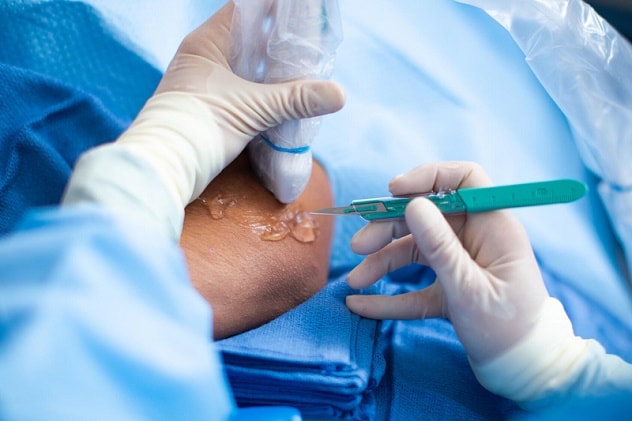June 09, 2023
Providing patients with improved function and long-term relief from chronic pain associated with tendinopathies is a clinical challenge. When conservative treatments such as the use of nonsteroidal anti-inflammatory drugs, bracing or physical therapy fail to be effective, surgical debridement of degenerative tendon tissue may be considered. In addition to the traditional open tenotomy, several forms of minimally invasive tenotomy are emerging.
بضع الوتر بالضغط المائي عبر الجلد

بضع الوتر بالضغط المائي عبر الجلد
يُجري اختصاصيو الطب الطبيعي وإعادة التأهيل في مايو كلينك عمليات بضع الأوتار عبر الجلد بمساعدة الموجات فوق الصوتية عن طريق ضخ محلول ملحي عالي الضغط لعلاج المرضى الذين يعانون من اعتلال الأوتار المزمن.
Mayo Clinic physical medicine and rehabilitation specialists are now performing ultrasound-guided percutaneous tenotomies using a high-pressure saline stream to treat patients with chronic tendinopathy. Also called percutaneous pressured hydrotenotomy, this procedure is performed on an outpatient basis, without the need for general anesthesia. The nonthermal stream has adjustable pressure and in-line suction that facilitates both debridement and aspiration of diseased tissue while preserving healthy surrounding tissue.
According to Jane Konidis, M.D., a physiatrist at Mayo Clinic's campus in Rochester, Minnesota, this treatment approach may be appropriate for patients with multiple diagnoses, including lateral and medial epicondylitis (tennis elbow and golfers elbow), calcific tendinopathy, plantar fasciitis, Achilles tendinopathy, patellar tendinopathy, rotator cuff tendinopathy and gluteal tendinopathy.
Dr. Konidis has more than three years of experience using hydrotenotomy to treat patients with chronic and calcific tendinopathy and plantar fasciitis.
"Typically, several weeks of rehabilitation and recovery are required, depending on the location of the procedure," explains Dr. Konidis. "We tell our patients that they can expect to see significant improvements in their symptoms, including pain relief and improved function, within the first six weeks and continued improvements in the following months."
Overall, Dr. Konidis has observed that outcomes among patients treated with hydrotenotomy at Mayo Clinic and elsewhere across the United States continue to be encouraging.
"My own experience has confirmed that the devices employed when performing hydrotenotomy are easier to use than some of the other minimally invasive tenotomy equipment available," explains Dr. Konidis. "The tool length allows me to reach more areas that require treatment, the device doesn't clog easily, and the saline jet does not inadvertently debride normal tendon. These distinctions make hydrotenotomy an effective and safe way to treat both diseased tendon and calcifications."
Published research data related to this procedure also confirm the procedure's safety and efficacy. Results from a study published in the Journal of Orthopaedics Experience & Innovation in 2022 demonstrated that use of an ultrasound-guided percutaneous pressured hydrotenotomy procedure provided patients with significant pain relief and functional recovery. This multicenter, prospective, single-arm study enrolled 29 patients with elbow tendinopathy pain that persisted for more than three months. Study participants had failed conservative care and had opted for this treatment approach. The researchers conducted post-procedure follow-ups at two and six weeks, and at three, six and 12 months.
For more information
Strauser-Curtis K, et al. Ultrasound-guided tenotomy via a hydrosurgery resection device improves symptoms of chronic elbow tendinopathy: A multi-center prospective study. Journal of Orthopaedics Experience & Innovation. Journal of Orthopaedics Experience & Innovation. 2022.
Refer a patient to Mayo Clinic.